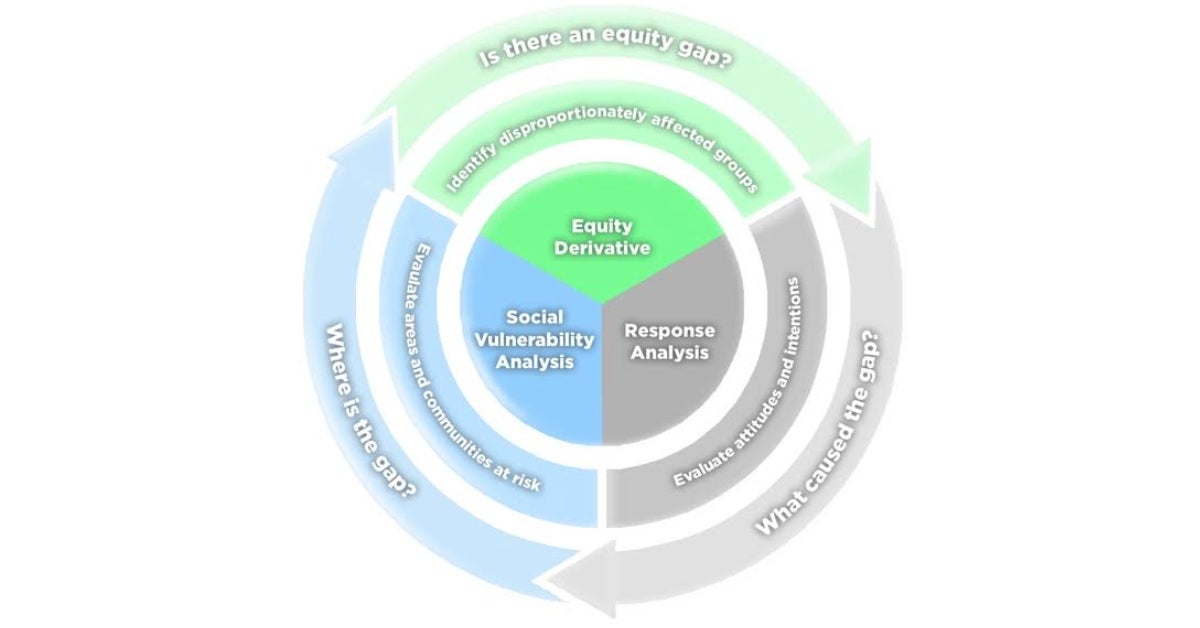ERDC establishes new center focused on public health and infrastructure research
Published 2:04 pm Wednesday, June 8, 2022

- The U.S. Army Engineer Research and Development Center’s Environmental Laboratory (ERDC-EL) is establishing an Engineering for Public Health and Human Factors (EPH) Center. The new center’s focus will be developing engineering and public health research and data analytics before, during and after crisis events for all manner of activities and applications, anywhere in the world. The above image is a graphical representation of the equity analysis methodology used by ERDC-EPH researchers. (U.S. Army Corps of Engineers photo)
The U.S. Army Engineer Research and Development Center’s (ERDC) Environmental Laboratory (EL) is establishing an Engineering for Public Health and Human Factors (EPH) Center. The new center’s focus will be developing engineering and public health research and data analytics before, during and after crisis events for all manner of activities and applications, anywhere in the world.
During the COVID -19 pandemic, researchers realized there was a significant gap in capability in how the federal government deals with human factors in the context of engineered infrastructure questions.
“Everything comes back to three things: money, labor and lives,” said Dr. Benjamin Trump, ERDC research social scientist and EPH lead. “Our research will help reduce spending, help reduce the amount of time it takes to either build up a service or remove unnecessary redundancies and help minimize risks to life.”
“When the pandemic started, the White House and governors of a number of states were reaching back to the U.S. Army Corps of Engineers to build field hospitals and alternative care capacity,” Trump continued. “This approach was necessary at the onset of the pandemic, but as we gained more information on COVID’s transmission rate and epidemiological forecast, we needed to think of analytical approaches that better prioritize scarce labor and resources for infrastructure response.”
The problem, according to Trump, was the lack of capability to see where investments in priority development should be currently versus a month or six months down the road. This gap was due to limited labor and financial resources — there were bottlenecks in how responders could address many parallel crises across the country.
The EPH Center will work to accomplish two objectives. First, the EPH Center will house ample capability to address a wide range of infrastructure, health and human factor-based questions for any type of crisis.
Second, when there is no crisis, the EPH Center will investigate how human factors and health-based inputs and outputs should be considered when making infrastructure planning and analysis.
“We are trying to take what we learned through the COVID process and build from it,” Trump said. “EPH will research a broad swathe of issues, from epidemiological modeling within critical transit and infrastructure centers to how choices by individuals pursuing their daily routines through infrastructure — like getting to and from work on mass transit centers ― influence health outcomes.”
While individual agencies fulfill research needs in engineering, infrastructure or public health, there is a critical gap where health is an essential variable for consideration when engineered infrastructure is planned, designed, built, retrofitted, operated, maintained or demolished. Additionally, there are many authorities on engineering and health in separate quarters, but the link between the two is weak.
Trump, Dr. Igor Linkov, U.S. Army Corps of Engineers (USACE) Command Surgeon Capt. Thomas Janisko, and the rest of the EPH Center team are partnering with the Federal Emergency Management Agency (FEMA), the U.S. Department of Health and Human Services, the Army and other entities wanting to look at the research and development capability that exists at the intersection of health and infrastructure.
The EPH Center will focus on situations where public health is a foundational cause of or disruptor to complex infrastructure systems. The EPH Center will not only serve civil agency efforts, but also military needs by improving public health initiatives using unique engineering capabilities.
“About a year ago, before the EPH Center was officially created, the team was asked to assist FEMA Region 1 with identifying a site for the mass COVID-19 vaccination campaign in Boston,” Trump said.
The city of Boston is a huge population center that was home to a large number of at-risk individuals and with infrastructure that is at a premium. Based on the type of research that will now be housed in the EPH Center, Trump and his team advised FEMA to push the vaccination site to Hynes Convention Center to serve as many Bostonians as possible.
“We developed a justification for setting up vaccine distribution capability in Hynes Convention Center that showed that it’s not just about getting shots in arms, but it’s also about reaching out to communities that are traditionally underserved or are going to have a relatively difficult time reach out to federal service,” said Trump.
The EPH Center will help bridge the gap between engineering solutions and public health needs and human factors. The EPH Center team will intervene when there is extreme uncertainty and be able to indicate how strategic choices, or the absence of those choices while information is being gathered, and what that means in terms of outcomes to money, labor and lives.
“If we’re investing in certain communities towards engineered infrastructure, the EPH Center will bridge the development to look at how people use or don’t use certain pieces of infrastructure over time — how is that influenced by human behavior as an input, and how does that influence health as an output,” Trump said.
“What will make EPH successful is its ability to leverage ERDC’s unique, well-postured and transdisciplinary research competencies and capacity to resolve critical knowledge gaps of future health risk scenarios,” said Dr. Edmond Russo, ERDC-EL director. “We’re excited about harnessing these capabilities to resolve future health risk challenges for the U.S. military and the Nation.”





